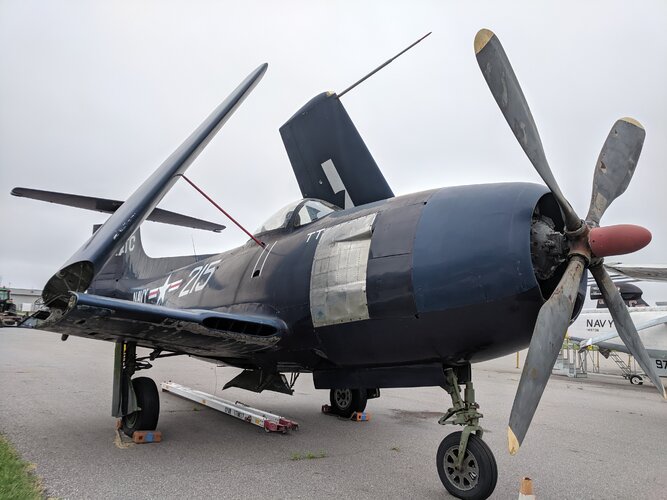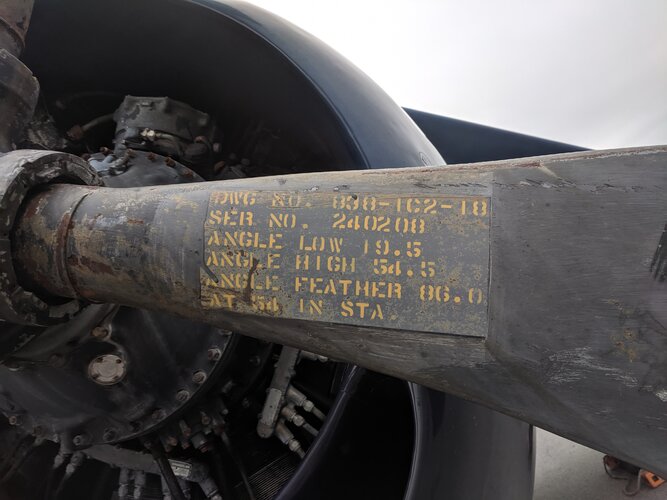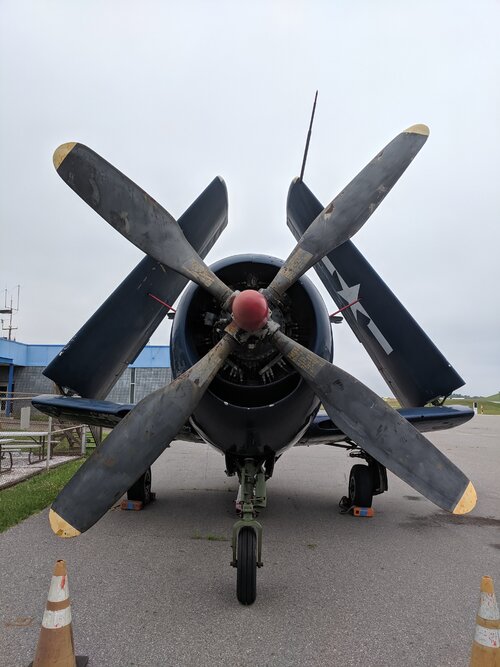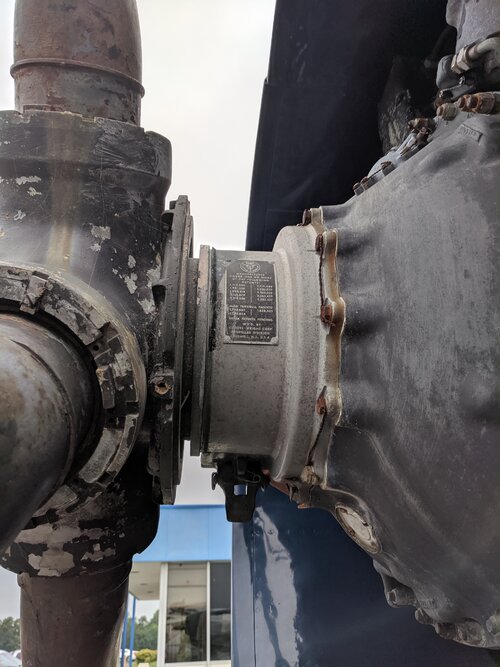Photographs of the Curtiss XF15C from the San Diego Air & Space Museum Archives.
Source:
http://www.flickr.com/photos/sdasmarchives/page55/
Source:
http://www.flickr.com/photos/sdasmarchives/page55/
Is this photo backwards or is the propellor pitched backwards?Photo I took a while back of the only surviving airframe, currently on display outside the Hickory Aviation Museum in North Carolina. I have a few more photos, including details, but they're stored on another device at the moment.
Definitely the right way around, look at the lettering on the tow-bar(?) on the ground under the fuselage.Is this photo backwards or is the propellor pitched backwards?Photo I took a while back of the only surviving airframe, currently on display outside the Hickory Aviation Museum in North Carolina. I have a few more photos, including details, but they're stored on another device at the moment.
I wonder why they pitched the prop for left hand rotation then.Definitely the right way around, look at the lettering on the tow-bar(?) on the ground under the fuselage.Is this photo backwards or is the propellor pitched backwards?Photo I took a while back of the only surviving airframe, currently on display outside the Hickory Aviation Museum in North Carolina. I have a few more photos, including details, but they're stored on another device at the moment.
Right-hand rotation but reverse thrust?I wonder why they pitched the prop for left hand rotation then.Definitely the right way around, look at the lettering on the tow-bar(?) on the ground under the fuselage.Is this photo backwards or is the propellor pitched backwards?Photo I took a while back of the only surviving airframe, currently on display outside the Hickory Aviation Museum in North Carolina. I have a few more photos, including details, but they're stored on another device at the moment.
Did it have reverse? I’ve never read that it did.Right-hand rotation but reverse thrust?I wonder why they pitched the prop for left hand rotation then.Definitely the right way around, look at the lettering on the tow-bar(?) on the ground under the fuselage.Is this photo backwards or is the propellor pitched backwards?Photo I took a while back of the only surviving airframe, currently on display outside the Hickory Aviation Museum in North Carolina. I have a few more photos, including details, but they're stored on another device at the moment.
Nor I. But it would seem a logical explanation for an unexpected prop pitch.Did it have reverse? I’ve never read that it did.Right-hand rotation but reverse thrust?I wonder why they pitched the prop for left hand rotation then.Definitely the right way around, look at the lettering on the tow-bar(?) on the ground under the fuselage.Is this photo backwards or is the propellor pitched backwards?Photo I took a while back of the only surviving airframe, currently on display outside the Hickory Aviation Museum in North Carolina. I have a few more photos, including details, but they're stored on another device at the moment.
You would think a museum would do better.It may just be a poorly assembled prop. The prop is pitched to turn counter-clockwise as viewed from in front of the airplane in all of the other pictures of the aircraft. I once saw a Pershing I missile with its triangle section fins mounted flat side forward!! Every frickin one of them!
It might have been done intentionally to make the aircraft non-flyable.You would think a museum would do better.It may just be a poorly assembled prop. The prop is pitched to turn counter-clockwise as viewed from in front of the airplane in all of the other pictures of the aircraft. I once saw a Pershing I missile with its triangle section fins mounted flat side forward!! Every frickin one of them!
I’m sure there are plenty of other things that make it unairworthy even with the prop pitched correctly.It might have been done intentionally to make the aircraft non-flyable.You would think a museum would do better.It may just be a poorly assembled prop. The prop is pitched to turn counter-clockwise as viewed from in front of the airplane in all of the other pictures of the aircraft. I once saw a Pershing I missile with its triangle section fins mounted flat side forward!! Every frickin one of them!
You never know with the FAA...I’m sure there are plenty of other things that make it unairworthy even with the prop pitched correctly.It might have been done intentionally to make the aircraft non-flyable.You would think a museum would do better.It may just be a poorly assembled prop. The prop is pitched to turn counter-clockwise as viewed from in front of the airplane in all of the other pictures of the aircraft. I once saw a Pershing I missile with its triangle section fins mounted flat side forward!! Every frickin one of them!
Does it have a civilian registration?You never know with the FAA...I’m sure there are plenty of other things that make it unairworthy even with the prop pitched correctly.It might have been done intentionally to make the aircraft non-flyable.You would think a museum would do better.It may just be a poorly assembled prop. The prop is pitched to turn counter-clockwise as viewed from in front of the airplane in all of the other pictures of the aircraft. I once saw a Pershing I missile with its triangle section fins mounted flat side forward!! Every frickin one of them!
You would think a museum would do better.It may just be a poorly assembled prop. The prop is pitched to turn counter-clockwise as viewed from in front of the airplane in all of the other pictures of the aircraft. I once saw a Pershing I missile with its triangle section fins mounted flat side forward!! Every frickin one of them!
It isn’t a turboprop. Piston and jet.You would think a museum would do better.It may just be a poorly assembled prop. The prop is pitched to turn counter-clockwise as viewed from in front of the airplane in all of the other pictures of the aircraft. I once saw a Pershing I missile with its triangle section fins mounted flat side forward!! Every frickin one of them!
Depends. Whether it is considered an absolute priority, and a rarity.
Make no mistake: I know it has historical value... for us, aviation history buffs and nerds.
We do know its a Ryan Fireball rival and turboprop mixed propulsion fighter; one of the last Curtiss, including for the USN...
But a museum lives also for the general public, which has no clue whatsoever about all this.
Case in point: France Musée de l'Air et de l'Espace, the reserves at Dugny. Aircraft stored outside, even rare and precious ones (the Mirage 4000 was in poor shape before its brilliant restauration). Not because they don't care, just a) lack of hangar space b) lack of time and human resources forcing cruel choices in priorities.
IIRC, the prop spinner was removed to improve the cooling of the R-2800 engine (much like the removal of the spinners from the XF7F when the design was modified for production).It might well be, looking at the pictures in this thread of the flying XF15C, that the prop isn't original to the aircraft, but rather one fitted because the original was missing. It certainly doesn't have the large cap over the hub that is in the photos.




Museums are a benefit of societies that have a respect and appreciation for what has come before. They don't operate like businesses that can sell products and expect regular cashflow. They survive off the charity of those who care about their existence which means that they don't have the funds to go out and hire an A&P mechanic and do the research to find the necessary manuals and documentation.
I would bet that the persons who put the prop together were volunteers who did the best they could with what they had and made up for their lack of experience with enthusiasm. There may very well have been no documentation and the people who built the airplane are long gone.
As far as a misassembled prop keeping this airplane from flying, because of its age and condition all of the systems would need to be gone through and overhauled and signed off on and that could take months to years. No one is going to get this airplane flying ever.
My guess is that the prop assemblers were people with enough mechanical skill to assemble the prop, but may not have been "airplane" people with enough knowledge to know that all the blades should have the same pitch in the correct direction.
Was that at or near Quonset Point NAS? I think I recall seeing the weathered old machine on static display at a few airshows there. When did they move it down south?I remember seeing the surviving type at the Quonset museum when I used to live in Rhode Island. What a shame that the museum closed down...
That particular XF15C had a pretty nomadic life. I know it was at the New England Air Museum, then at Quonset Point (the museum shut down after a weather-related building collapse). It's nice to see it found a home in another museum.Was that at or near Quonset Point NAS? I think I recall seeing the weathered old machine on static display at a few airshows there. When did they move it down south?I remember seeing the surviving type at the Quonset museum when I used to live in Rhode Island. What a shame that the museum closed down...
